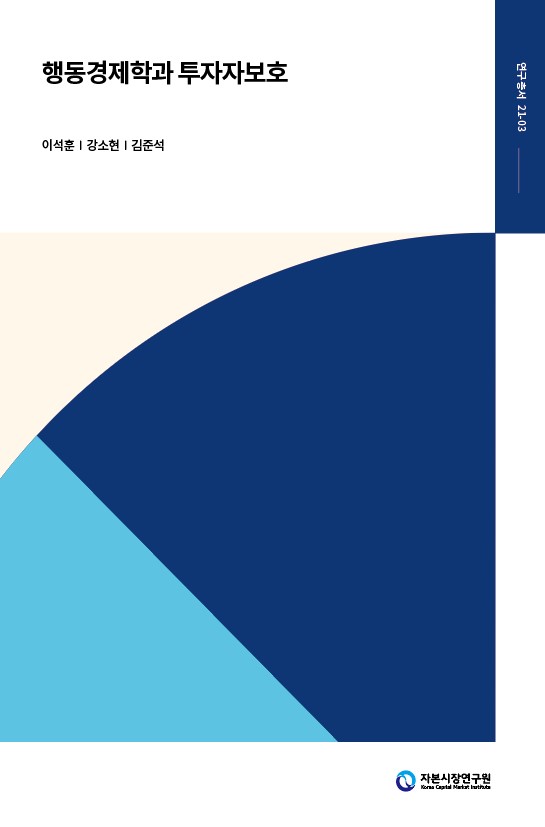Find out more about our latest publications

Behavioral Economics and Investor Protection
Research Series 21-03 Mar. 09, 2021
- Research Topic Asset Management/Pension
- Page 226
Behavioral Economics and Investor Protection
As households’ financial assets increase, more people are routinely exposed to the financial services, such as general consumer goods. In addition, the demand for financial services of the elderly and those with lower financial literacy has been increasing significantly. Recently, several structural changes such as the popularization of financial investment products, the emergence of complex financial instruments, and the growth of retirement pensions have highlighted problems of investor protection due to lack of the customers’ financial literacy or behavioral bias. Behavioral bias refers to a psychological mechanism that systematically triggers human behavior deviated from the rationality assumed by traditional economics. Thus, to the extent of behavioral bias, investor protection policies based on the premise of human's rationality may not be effective. This is also the reason why countries are paying attention to the behavioral insights in establishing investor protection policies.
Recently, the Korea’s financial authority has also been moving to apply behavioral insights to the investor protection policies. However, any research has not helped the financial authority to establish the policies suitable for our reality from a behavioral perspective. Therefore, our study takes the first step by focusing on the behavioral bias of investors choosing financial investment instruments in the capital market and discusses how to protect them from a behavioral perspective.
We look at the behavioral characteristics of Korean fund investors from a behavioral perspective. It is found that the financial literacy and the acquired information of fund investors are not sufficient. First of all, efficient financial education is needed to enhance fund investors’ financial understanding in order to lower the fund investors’ dependence on others and induce the rational decision based on their preferences. For effective financial education, the behavioral characteristics of persons subject to education should be analyzed in advance and effective goals subdivided according to their incentives and characteristics for participation in financial education be presented. Improvements to fund-related disclosures are also needed to enhance investors’ access to and understanding of disclosures. Guidelines for key information to be provided to investors should be drawn up and forms of disclosure should be designed so that investors can easily understand the information and fully consider it for their investment decision. Finally, improvements are required to reduce the likelihood of conflicts of interest between financial institutions and investors.
The fundamental cause of behavioral bias in the decision- making process of investment in derivative linked securities is the complexity of the product. In particular, financial institutions have the incentive to design revenue structures and establish marketing strategies by utilizing investors’ behavioral bias to maximize profits. Therefore, to ensure investor protection and reliability for complex financial instruments such as derivative linked securities, a policy instrument needs to be devised to correct behavioral bias or reduce its influence so that the principle of self-responsibility can be accepted more effectively. Major policy measures have already been introduced in Korea. Nevertheless, to strengthen the effectiveness of the regulations, further discussions on improving the system seem to be needed. First, it is necessary to ensure consistency in the application of investor conformity principles. Second, it is necessary to improve the risk rating system for derivative linked securities and the format of information provision. Third, the sales activities of financial institutions that cause investors' behavioral bias should be eradicated. Finally, the listing of derivative linked securities should be induced.
Korea’s DC retirement pension members put their pension assets mainly on the deposit or saving products, which is far different from the current structure of overseas DC pension assets, which places a high share of stocks. This may be due to DC plan members’ preference for safe management of pension assets. However, there seem to be more significant factors behind that. the first may be due to the lack of financial understanding of the retirement pension savings by Korean DC plan members since the retirement pension system was introduced not long ago. Secondly, it may be because Korean DC plan members choose or select the deposit products due to behavioral bias such as psychological accounting, peer effects, procrastination, and myopic loss avoidance. In response, we propose to introduce choice architecture for DC plan members who lack financial understanding or have no clear preference. Specifically, the introduction of default options, re-enrollment, tiered investment line-up, the institution supporting for small and medium-sized enterprises such as UK's NEST model, and effective pension information disclosure methods were proposed.
As households’ financial assets increase, more people are routinely exposed to the financial services, such as general consumer goods. In addition, the demand for financial services of the elderly and those with lower financial literacy has been increasing significantly. Recently, several structural changes such as the popularization of financial investment products, the emergence of complex financial instruments, and the growth of retirement pensions have highlighted problems of investor protection due to lack of the customers’ financial literacy or behavioral bias. Behavioral bias refers to a psychological mechanism that systematically triggers human behavior deviated from the rationality assumed by traditional economics. Thus, to the extent of behavioral bias, investor protection policies based on the premise of human's rationality may not be effective. This is also the reason why countries are paying attention to the behavioral insights in establishing investor protection policies.
Recently, the Korea’s financial authority has also been moving to apply behavioral insights to the investor protection policies. However, any research has not helped the financial authority to establish the policies suitable for our reality from a behavioral perspective. Therefore, our study takes the first step by focusing on the behavioral bias of investors choosing financial investment instruments in the capital market and discusses how to protect them from a behavioral perspective.
We look at the behavioral characteristics of Korean fund investors from a behavioral perspective. It is found that the financial literacy and the acquired information of fund investors are not sufficient. First of all, efficient financial education is needed to enhance fund investors’ financial understanding in order to lower the fund investors’ dependence on others and induce the rational decision based on their preferences. For effective financial education, the behavioral characteristics of persons subject to education should be analyzed in advance and effective goals subdivided according to their incentives and characteristics for participation in financial education be presented. Improvements to fund-related disclosures are also needed to enhance investors’ access to and understanding of disclosures. Guidelines for key information to be provided to investors should be drawn up and forms of disclosure should be designed so that investors can easily understand the information and fully consider it for their investment decision. Finally, improvements are required to reduce the likelihood of conflicts of interest between financial institutions and investors.
The fundamental cause of behavioral bias in the decision- making process of investment in derivative linked securities is the complexity of the product. In particular, financial institutions have the incentive to design revenue structures and establish marketing strategies by utilizing investors’ behavioral bias to maximize profits. Therefore, to ensure investor protection and reliability for complex financial instruments such as derivative linked securities, a policy instrument needs to be devised to correct behavioral bias or reduce its influence so that the principle of self-responsibility can be accepted more effectively. Major policy measures have already been introduced in Korea. Nevertheless, to strengthen the effectiveness of the regulations, further discussions on improving the system seem to be needed. First, it is necessary to ensure consistency in the application of investor conformity principles. Second, it is necessary to improve the risk rating system for derivative linked securities and the format of information provision. Third, the sales activities of financial institutions that cause investors' behavioral bias should be eradicated. Finally, the listing of derivative linked securities should be induced.
Korea’s DC retirement pension members put their pension assets mainly on the deposit or saving products, which is far different from the current structure of overseas DC pension assets, which places a high share of stocks. This may be due to DC plan members’ preference for safe management of pension assets. However, there seem to be more significant factors behind that. the first may be due to the lack of financial understanding of the retirement pension savings by Korean DC plan members since the retirement pension system was introduced not long ago. Secondly, it may be because Korean DC plan members choose or select the deposit products due to behavioral bias such as psychological accounting, peer effects, procrastination, and myopic loss avoidance. In response, we propose to introduce choice architecture for DC plan members who lack financial understanding or have no clear preference. Specifically, the introduction of default options, re-enrollment, tiered investment line-up, the institution supporting for small and medium-sized enterprises such as UK's NEST model, and effective pension information disclosure methods were proposed.


